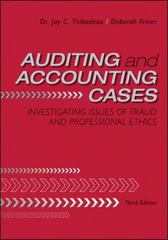Soon after the precipitous decline of Arizonas real estate market in 1989, BFA management decided to establish
Question:
Soon after the precipitous decline of Arizona’s real estate market in 1989, BFA management decided to establish a number of related affiliates. These affiliates were controlled by individuals with close ties to BFA, such as former board members.
Two of BFA’s most significant affiliates were ALO and New Church Ventures. A former BFA director incorporated both of these nonprofit entities. The entities had no employees of their own, and both organizations paid BFA substantial management fees to provide accounting, marketing, and administrative services.
As a result, both ALO and New Church Ventures owed BFA significant amounts by the end of 1995. On an overall basis, BFA, New Church Ventures, and ALO had a combined negative net worth (deficiency in assets) of \($83.2\) million at year-end 1995, \($102.3\) million at year-end 1996, and \($124.0\) million at year-end 1997.2 It was later revealed that BFA had sold real estate to both ALO and New Church Ventures at book value (or at a profit), even though the fair market value of the assets was actually significantly lower than the amounts recorded on BFA’s books. In addition, ALO had borrowed money from BFA and its related entities to provide the down payments necessary to execute the purchase transactions with BFA. As a result, ALO’s debt increased each year from 1989 to 1997, and its deficit from operations also increased each year.
BFA’s Independent Auditors From 1984 to 1998 BFA engaged Arthur Andersen as its independent auditor.
Arthur Andersen was also hired by BFA or BFA’s attorneys to perform other accounting and auditing, management consulting, and tax services. From 1984 to 1997 Arthur Andersen issued unqualified audit opinions on BFA’s combined financial statements.
From 1992 to 1998 Jay Steven Ozer was the Arthur Andersen engagement partner with the ultimate responsibility for the BFA audits, including the review of all audit work performed, resolution of all accounting issues, evaluating the results of all audit procedures, and signing the final audit opinions.
Ann McGrath was an auditor on the BFA engagement from 1988 to 1998. In 1991 she began her role as manager on the audit engagements. For audit years 1991 to 1998 McGrath had primary responsibility for all audit planning and field work, which included assessing areas of inherent and control risk, supervising the audit team, and reviewing all audit workpapers.3 Employees’ Concerns over ALO’s Deficit In April 1996 several of BFA’s accountants and one attorney were sufficiently concerned about ALO’s deficit situation and related financial viability issues to confront BFA’s senior management team. The response was perceived as inadequate by the employees. Due to their concerns about the lack of response by the BFA senior management..........
Case Questions
1. Define what is meant by control environment. Based on the information provided in the case, explain why the control environment is so important to effective internal control over financial reporting at an audit client like the Baptist Foundation of Arizona (BFA).
2. What is the role of the audit committee in the financial reporting process? Can you provide an example of how the audit committee might have been helpful in the BFA situation?
3. What is meant by the term whistleblower within the context of the financial reporting process? Do you think that all whistleblower complaints should go directly to the audit committee? Why or why not? Do you think that a whistleblower program would have been helpful at BFA? Why or why not?
4. Do you believe the Arthur Andersen auditors responded appropriately to the information received from BFA’s former accountant, Karen Paetz? Why or why not?
5. How would Section 401 apply to the BFA audit? Do you believe that Section 401 would have improved the presentation of BFA’s financial statements?
Step by Step Answer:

Auditing And Accounting Cases Investigating Issues Of Fraud And Professional Ethics
ISBN: 9780078110818
3rd Edition
Authors: Jay Thibodeau, Deborah Freier





